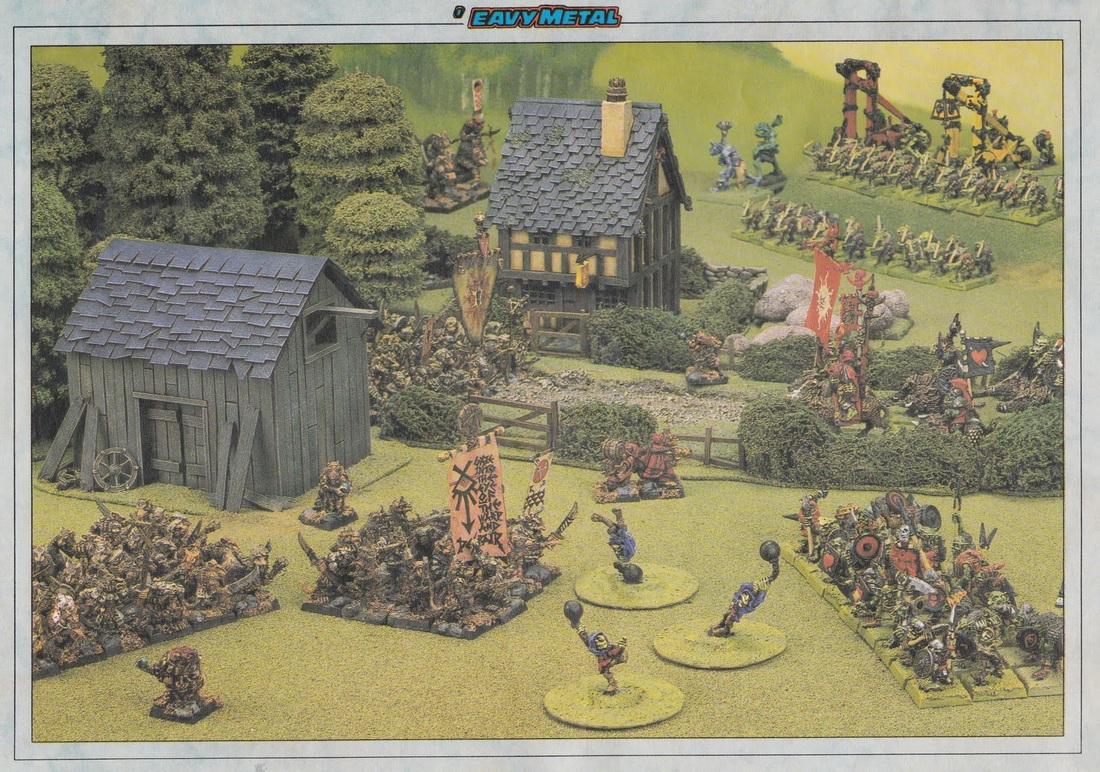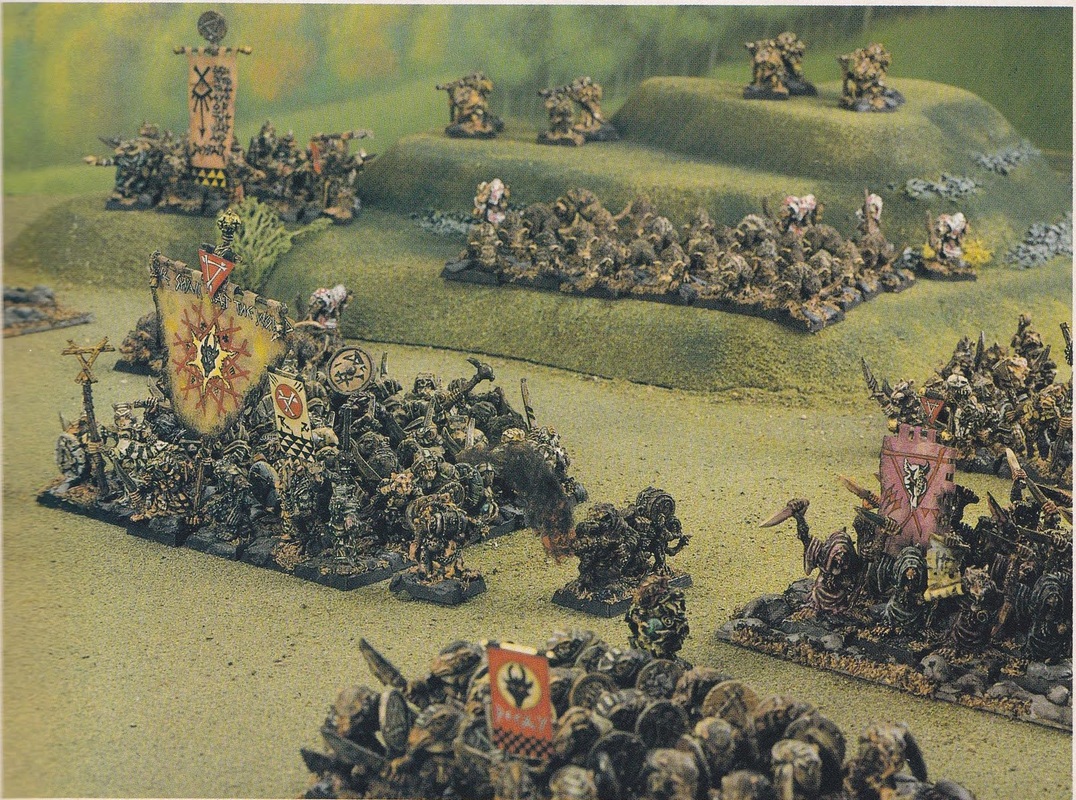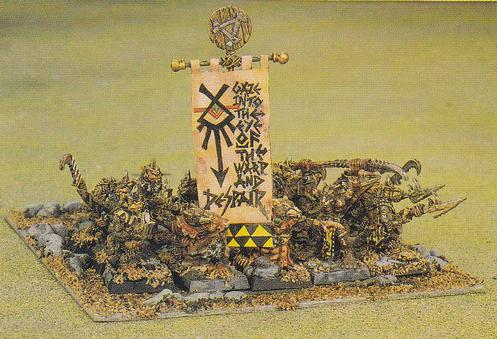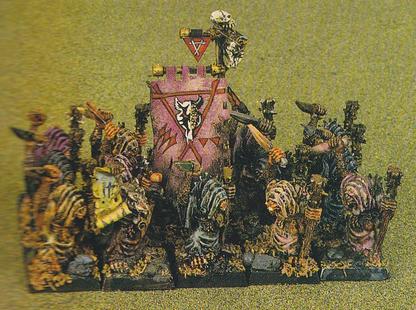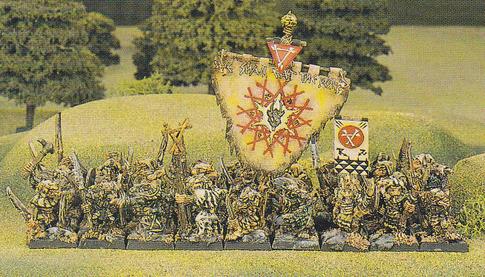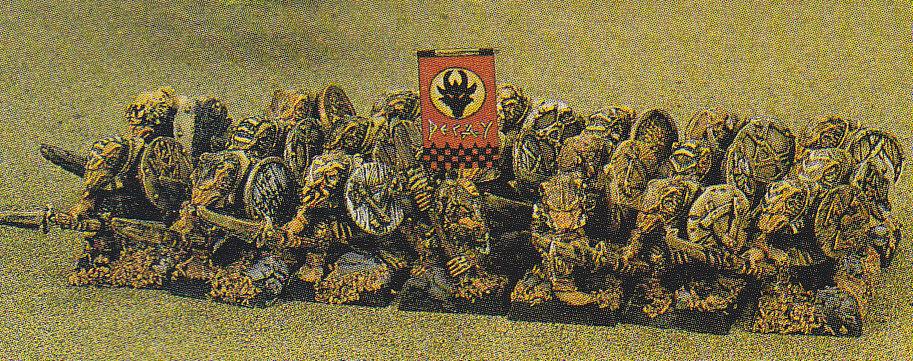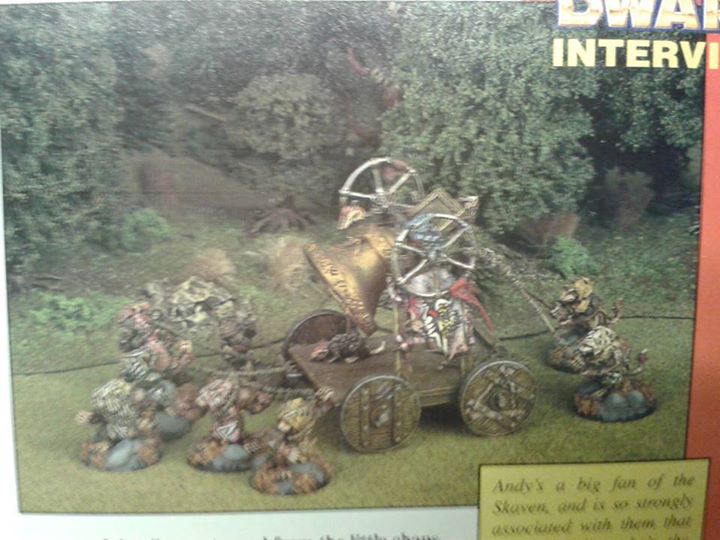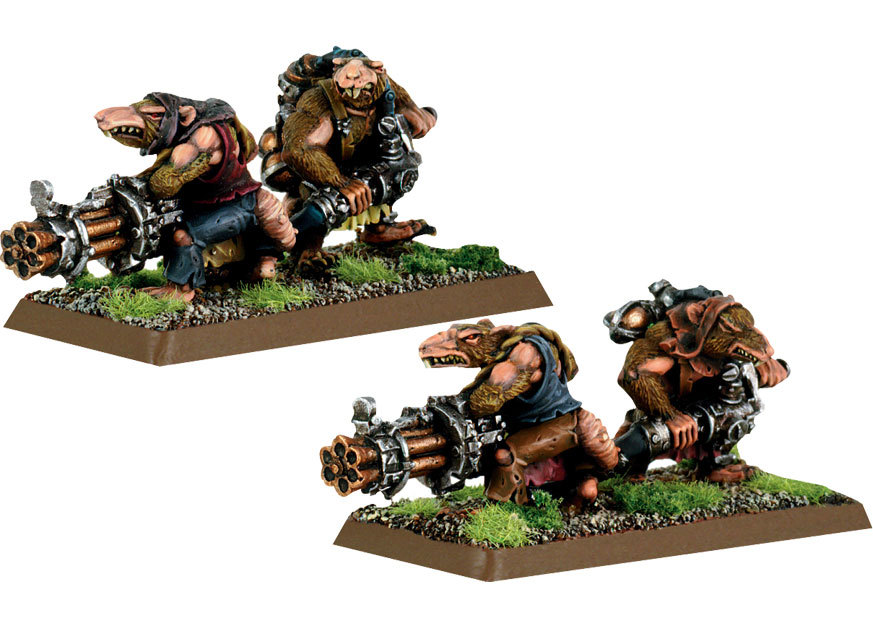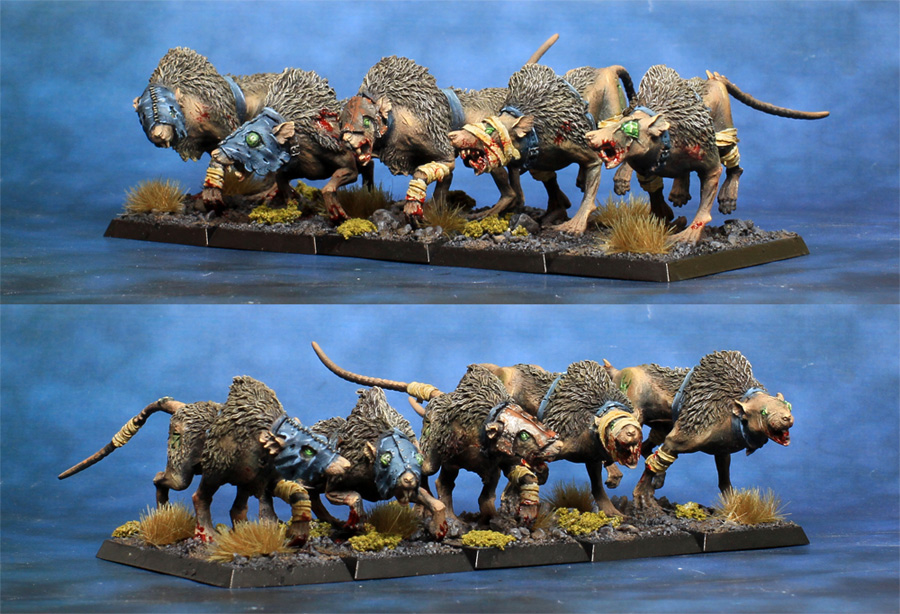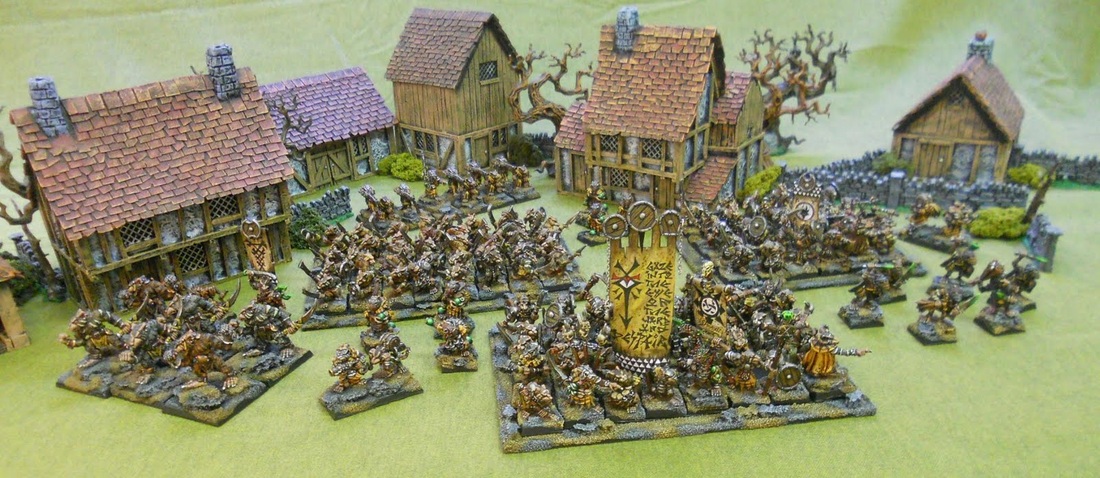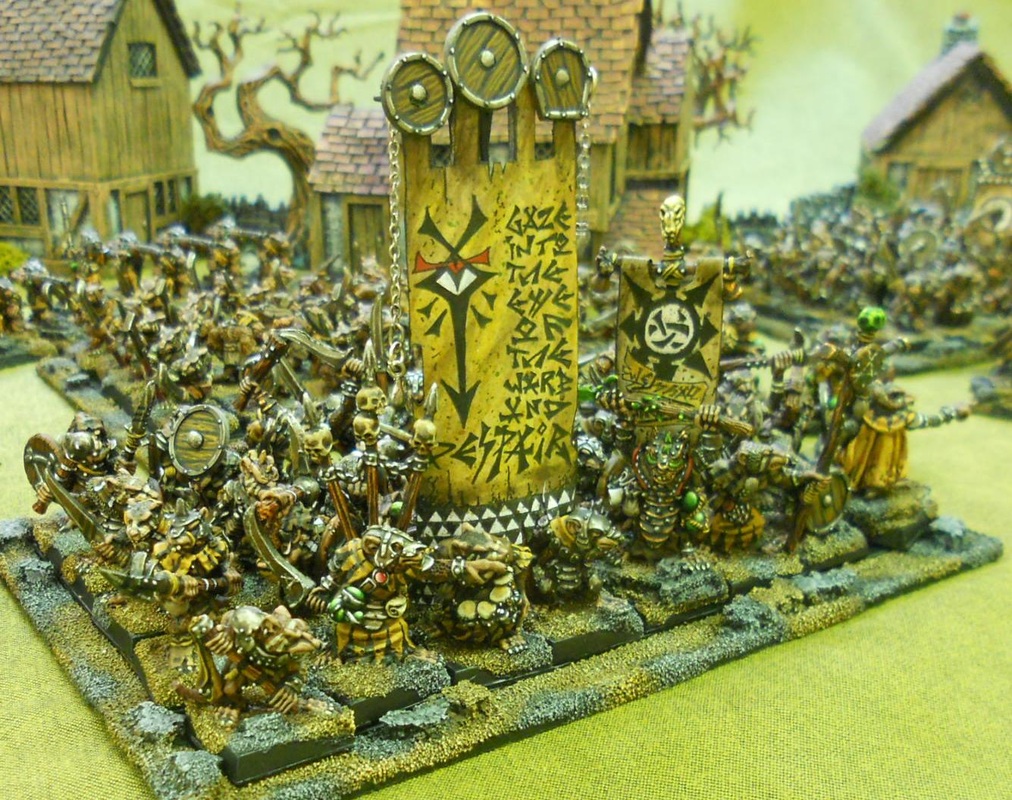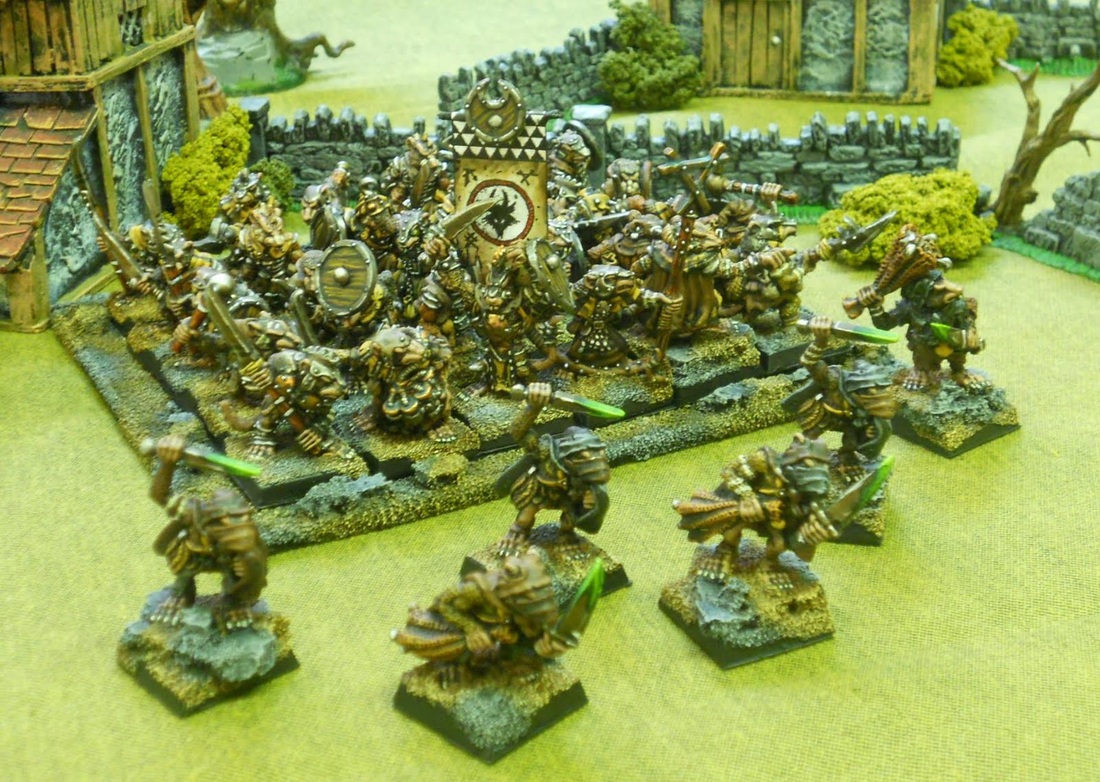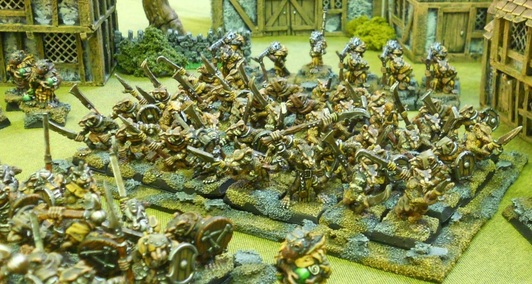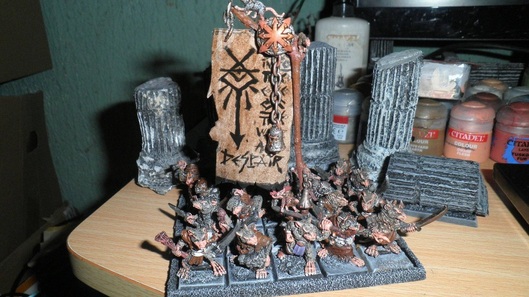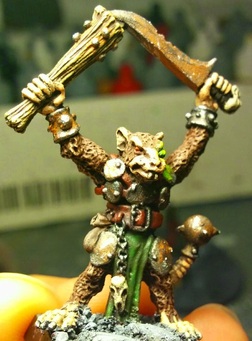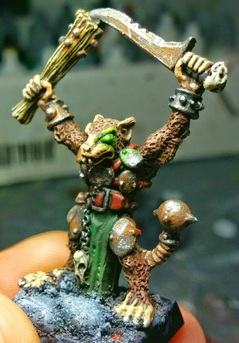"So many people down the years have cited it as the thing that got them into Skaven, or even into tabeltop gaming in general that it's quite humbling. I'll go to my grave knowing I got one thing right in life -how to paint a kickass-looking Skaven army."
-Andy Chambers
-Andy Chambers
In the previous post I touched on why Andy Chamber's Skaven Army has achieved a lasting reputation, here I'm going to attempt to evaluate how this was achieved. Within the article itself unfortunately very little information is provided in regards to Chmber's painting techniques; essentially the subject is only lightly touched on in these two paragraphs:
" I started painting my first fifty Clanrat models as a complete block. This proved to be a bit of a mistake as I later had to go back and paint some standard bearers and musicians for their regiments. Worse still. painting such a huge block of figures seemed to rake years! With subsequent painting I've stuck to doing groups of about twenty models at a time. If I paint quickly I can get that number finished over the course of maybe four or five evenings just putting on a couple colours at night.
This system of gradually building up colours on a large group of models rather than trying to complete several smaller groups does tend to make your army appear visually uniform and is more satisfying as the army progresses in perceptible leaps and bounds. Character figures are best painted separately so that you can lavish your full artistic attentions on them. Ideally regiments should be painted as complete blocks. I wasn't too sure exactly how big my regiments were going to be so I just painted with a view to having a consistent looking group of figures that could be organized into different regiments as necessary."
While this passage gives an overview of Chamber's approach and provides some indication of his goals, it scarcely touches on the specifics. Luckily for us, Andy recently offered some insight into his technique on the Oldhammer Facebook group:
"I used a black undercoat and pretty much dry brushed the colour on from a limited palette including a lot of white. Because of the black undercoat the inkwash is probably lighter than you think it is - Burnt Sienna and Peat Brown in a 3/1 mix thinned out with water - so it's a sort of dark amber colour rather than brown. I went back over them after the wash was dry and picked out some things - teeth, weapon edges, war paint on fur - in lighter colours to make them stand out a bit and relieve the brown-ness. Note; this all sounds very considered but I really just made it up as I went along."
" I started painting my first fifty Clanrat models as a complete block. This proved to be a bit of a mistake as I later had to go back and paint some standard bearers and musicians for their regiments. Worse still. painting such a huge block of figures seemed to rake years! With subsequent painting I've stuck to doing groups of about twenty models at a time. If I paint quickly I can get that number finished over the course of maybe four or five evenings just putting on a couple colours at night.
This system of gradually building up colours on a large group of models rather than trying to complete several smaller groups does tend to make your army appear visually uniform and is more satisfying as the army progresses in perceptible leaps and bounds. Character figures are best painted separately so that you can lavish your full artistic attentions on them. Ideally regiments should be painted as complete blocks. I wasn't too sure exactly how big my regiments were going to be so I just painted with a view to having a consistent looking group of figures that could be organized into different regiments as necessary."
While this passage gives an overview of Chamber's approach and provides some indication of his goals, it scarcely touches on the specifics. Luckily for us, Andy recently offered some insight into his technique on the Oldhammer Facebook group:
"I used a black undercoat and pretty much dry brushed the colour on from a limited palette including a lot of white. Because of the black undercoat the inkwash is probably lighter than you think it is - Burnt Sienna and Peat Brown in a 3/1 mix thinned out with water - so it's a sort of dark amber colour rather than brown. I went back over them after the wash was dry and picked out some things - teeth, weapon edges, war paint on fur - in lighter colours to make them stand out a bit and relieve the brown-ness. Note; this all sounds very considered but I really just made it up as I went along."
Looking at Andy Chamber's Skaven army en masse, the overall impression achieved is that of a brown, furry horde. In other words, the quintessential description of the chaos ratmen. This is primarily what distinguishes it from Skaven armies, particularly those of the GW studio, proceeding it, which tend towards a more liberal use of dynamic colours. The reasons for this are obvious; a predominantly brown horde can very easily become an indistinguishable mess on the board.
I think the key to understanding how Chambers avoids this problem can be found in two synonymous phrases quoted in the passage above: "visually uniform" and "consistent looking". Its my contention that these reference a concept that Mike McVey would later dub "coherency".
At its most basic, coherency refers to the consideration of how well the colour schemes of the models comprising a unit or an army fit together to create an overall effect. Normally this approach entails choosing a principal colour and one or two subsidiary colours for a unit, with the largest area on each model painted in the principal colour and smaller areas in the subsidiary colour(s). Any smaller details; such as belts, sheaths, bags, quivers; are then painted in neutral colours (brown, black, grey, white, etc.) so as not to distract from the colour scheme. Army coherency is then achieved by switching out the principal and subsidiary colours between units.
What makes Chamber's Skaven army unique is that the principal colours are themselves neutral colours. The difficulties posed by this are, in my estimation, counteracted primarily by Andy Chamber's use of muted colours, iconography, and unique bases.
I think the key to understanding how Chambers avoids this problem can be found in two synonymous phrases quoted in the passage above: "visually uniform" and "consistent looking". Its my contention that these reference a concept that Mike McVey would later dub "coherency".
At its most basic, coherency refers to the consideration of how well the colour schemes of the models comprising a unit or an army fit together to create an overall effect. Normally this approach entails choosing a principal colour and one or two subsidiary colours for a unit, with the largest area on each model painted in the principal colour and smaller areas in the subsidiary colour(s). Any smaller details; such as belts, sheaths, bags, quivers; are then painted in neutral colours (brown, black, grey, white, etc.) so as not to distract from the colour scheme. Army coherency is then achieved by switching out the principal and subsidiary colours between units.
What makes Chamber's Skaven army unique is that the principal colours are themselves neutral colours. The difficulties posed by this are, in my estimation, counteracted primarily by Andy Chamber's use of muted colours, iconography, and unique bases.
Looking closer at the army, one can see that colours were used: ragged red and yellow cloaks adorn various Clanrats, while Andy's Plague Monks even sport an unconventional mixture of violets and blues, but in no instances do these overpower the effect of the neutral principal colours, save one effective exception. The colours form accents, but are muted in tone and heavily shaded or washed, allowing visual distinction without distraction. The exception mentioned was Andy's choice to clad his Moulder packmasters in white robes, with red symbols, though this again serves to distinguish these models from the hordes of brown-furred giant rats and rat ogres they accompany. Also worth noting here is some of the smaller details not readily apparent on first glance that nonethless contribute to coherency, such as the use of white 'tribal markings' on fur and the red ribbons adorning the hilts of characters's weaponry.
By Iconography I refer of course to Chamber's unique and striking banners, which have perhaps inspired the most homages throughout the years. In stark contrast to the muted colours of the regiments, the banners are brightly-coloured and dynamic, featuring such infamous mottoes as "Gaze Into The Eye Of The Warp And Despair" and "We Shall Eat The World", framed by Skaven runic designs. These form visual focal points for the army, providing a contrasting element that draw's the eye's immediate attention. Besides the units's over-sized banners ( 2 Relic Banners and a Bane Banner, according to the army list), several characters also sport back banners (sashimono) that distinguishes them from the rank & file.
Update: Modestly, Andy Chambers offered this clarification: "By the way I should note that those lovely banners and ribbons on weapons were done with a great deal of help from the 'eavy metal team and the banners themselves were photocopied down from the Jes Goodwin designs in the first Skaven article. You're absolutely right that they added a needed strong splash of colour to the army but I can't claim sole credit for it." A fair enough concession.
Update: Modestly, Andy Chambers offered this clarification: "By the way I should note that those lovely banners and ribbons on weapons were done with a great deal of help from the 'eavy metal team and the banners themselves were photocopied down from the Jes Goodwin designs in the first Skaven article. You're absolutely right that they added a needed strong splash of colour to the army but I can't claim sole credit for it." A fair enough concession.
Much more subtle than the banners, but of equal or greater importance to cohesion and the army's overall visual impact are Andy Chamber's wonderful bases. I recently asked Chambers if he might provide more information on these to which he replied:
"I used blobs of milliput (2part modelling putty) to make the stones during assembly and painted them grey as part of the painting process. The flock I used is a coarse-grained one intended for railway ballast I think.I chose to base them that way because I felt like it would extend the corruption theme better than having them on perfect little green lawns. An added plus was they were still suitable for using in D&D. When I started the army I had a couple of dozen assorted Skaven I painted with a friend to use as monsters for a D&D campaign, they were like the seeds of the whole thing."
This attention to detail serves both to tie the army together and strongly contrast it against the game board and opponents. The combination of dark stonework strewn with what could be autumn foliage or the run-off of sewers, accentuates and enhances the colours of the troops and adds another layer to the cohesion of the army. Chambers also utilizes several movement trays that mirror and extend the visuals of the bases. Its the bases, I firmly believe, that cements the powerful impression left by the army on all who see it.
"I used blobs of milliput (2part modelling putty) to make the stones during assembly and painted them grey as part of the painting process. The flock I used is a coarse-grained one intended for railway ballast I think.I chose to base them that way because I felt like it would extend the corruption theme better than having them on perfect little green lawns. An added plus was they were still suitable for using in D&D. When I started the army I had a couple of dozen assorted Skaven I painted with a friend to use as monsters for a D&D campaign, they were like the seeds of the whole thing."
This attention to detail serves both to tie the army together and strongly contrast it against the game board and opponents. The combination of dark stonework strewn with what could be autumn foliage or the run-off of sewers, accentuates and enhances the colours of the troops and adds another layer to the cohesion of the army. Chambers also utilizes several movement trays that mirror and extend the visuals of the bases. Its the bases, I firmly believe, that cements the powerful impression left by the army on all who see it.
The article concludes with a passage that not only aptly displays the creativity Andy Chambers freely invested in the army, but is also uncannily portentous of things to come...
"Though I've still a number of rank and file to paint before the army is completed to my satisfaction, I've already started converting and building extra stuff for the army. The first thing I did was convert a special riding Rat Ogre for a Clan Moulder Warlord - after being consistently mauled by mounted heroes I've decided it's time to get my own back! ( For the moment we're just counting him as a Rat Ogre, hopefully we'll bang some rules together at a later date). Other projects in hand involve building a Screaming Bell cart, some Wolfrat conversions and a two-rat Gattling team."
I've written about Chamber's Screaming Bell prototype in a previous post, though its worth sharing here again:
"Though I've still a number of rank and file to paint before the army is completed to my satisfaction, I've already started converting and building extra stuff for the army. The first thing I did was convert a special riding Rat Ogre for a Clan Moulder Warlord - after being consistently mauled by mounted heroes I've decided it's time to get my own back! ( For the moment we're just counting him as a Rat Ogre, hopefully we'll bang some rules together at a later date). Other projects in hand involve building a Screaming Bell cart, some Wolfrat conversions and a two-rat Gattling team."
I've written about Chamber's Screaming Bell prototype in a previous post, though its worth sharing here again:
The "two-rat Gatling team" is no doubt a precursor to the Rattling Gun, a weapons team option featured in Skaven armies since 6th edition:
And the Moulder Warlord atop a Rat Ogre mount, converted from a Skaven Blitzer from the Bloodbowl team by Jes Goodwin, is no doubt the first extant example of the Rat Ogre Bonebreaker, which would not receive official rules until the end of 7th edition.
Wolfrats, oddly, were excised from the army roster as of 4th edition and (besides a brief appearance in the Moulder Hell Pit army list in White Dwarf #310) were only recently re-introduced via Forgeworld and the 8th edition supplement Storm of Magic (infamous for also re-introducing Fimir and Zoats, albeit in a rather limited fashion).
Wolfrats, oddly, were excised from the army roster as of 4th edition and (besides a brief appearance in the Moulder Hell Pit army list in White Dwarf #310) were only recently re-introduced via Forgeworld and the 8th edition supplement Storm of Magic (infamous for also re-introducing Fimir and Zoats, albeit in a rather limited fashion).
The legacy of Andy Chamber's Skaven army is distinctly felt and seen throughout the Oldhammer community. Just in reaction to my last post, many commentators stepped forward to state it was this very article that inspired their lasting love for the Chaos Ratmen. A few have taken this further, with homages and recreations of the seminal army.
Of these, first and foremost is no doubt the Skaven army of Nico, chronicled in his Realms of Chaos plog.
Nico's breathtaking tribute is an inspiration to any Oldhammer painter, and manages to capture the essence of Andy Chamber's army while still claiming a visual style all its own.
Fred Fouchet was likewise inspired by Andy Chamber's Skaven army in his recent Oldhammer contribution:
Fred Fouchet was likewise inspired by Andy Chamber's Skaven army in his recent Oldhammer contribution:
Also of note is the ongoing project of Mukitauro, who has plans to create an army along similar notions.
Even as I write this, Skaven popularity is on the rise in the Olhammer circles, with ebay prices on Jes Goodwin figures jumping sharply in just the last few months. No doubt we'll be seeing many more armies paying tribute to the lasting impact of Andy Chamber's masterpiece in the near future.
UPCOMING: Skaven in Space, the history of the Hrud and the 40k army that might have been; Shroedinger's Skaven, a look at the Ratmen's roles in GW's boxed games, from HeroQuest to Mordheim; A Rat By Any Other Name, a look at the varied Skaven proxies offered by other miniature creators over the years; and The True Name of The Horned Rat, exploring my personal theory as to the secret identity of the Skaven's deity.
UPCOMING: Skaven in Space, the history of the Hrud and the 40k army that might have been; Shroedinger's Skaven, a look at the Ratmen's roles in GW's boxed games, from HeroQuest to Mordheim; A Rat By Any Other Name, a look at the varied Skaven proxies offered by other miniature creators over the years; and The True Name of The Horned Rat, exploring my personal theory as to the secret identity of the Skaven's deity.
